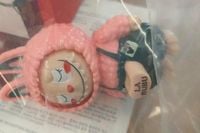It started with a quirky, sharp-toothed toy that caught the world’s attention. The Labubu doll, designed by Chinese toy giant Pop Mart, became an overnight sensation after going viral on social media and being flaunted by celebrities like Rihanna. Kids and collectors alike scrambled to get their hands on the furry, elf-like creatures, sometimes paying hundreds of pounds for a single authentic doll. But as the popularity of Labubu soared, so did the darker side of its fame: a flood of dangerous counterfeits sweeping into the UK market, putting children at real risk.
On September 25, 2025, the UK’s Intellectual Property Office (IPO) revealed that more than £3.5 million worth of counterfeit toys had been seized at the border this year alone. According to Home Office data cited by The Guardian and Sky News, that’s nearly 259,000 fake toys intercepted before they could reach store shelves or online shoppers. The most shocking detail? About 236,000 of those—roughly nine in ten—were fake Labubu dolls, known on the street as "Lafufus."
Why the obsession with Labubu? The dolls’ viral status, fueled by influencer unboxings and celebrity endorsements, made them a must-have for children and pop culture fans. As demand skyrocketed, so did the incentives for counterfeiters. Authentic Labubu dolls can cost hundreds of pounds, while fake versions are hawked for as little as £20. It’s no wonder that, as Yahoo News reports, the market for knockoffs exploded overnight.
But a cheap price tag comes at a steep cost. Expert testing found that 75% of the fake toys seized this year failed essential safety checks. The risks aren’t minor: many of the dolls contained banned chemicals—including some linked to cancer—and featured small, detachable parts that pose a choking hazard, especially for young children. In early September, authorities raided two shops in West London and seized 100 "Lafufu" dolls. The dolls, designed to be clipped onto bags, had feet and eyes that could easily pop off and block a child’s airway. Similar raids in Derby, Moray, and Walsall uncovered hundreds more dangerous counterfeits.
Helen Barnham, deputy director of enforcement at the IPO, didn’t mince words about the threat. "With counterfeit toys, what you see is rarely what you get. Behind the packaging can be hidden choking hazards, toxic chemicals and faulty parts that put children in real danger," Barnham told Sky News. "These products have bypassed every safety check the law requires, which is why we’re working with our partners to keep these dangerous fakes out of UK homes."
The numbers behind the crisis are sobering. Nearly half—46%—of people who bought counterfeit toys reported serious safety issues, according to IPO research referenced by The Guardian. Problems ranged from toys breaking almost instantly to dangerous labeling, toxic odors, and even cases where children fell ill. The Chartered Trading Standards Institute (CTSI) and local councils have repeatedly warned that poorly made fakes, often sold in corner shops or through online marketplaces, can contain small removable parts like eyes, arms, and legs—posing a serious choking hazard to young children.
So why do so many parents and gift-givers take the risk? A recent IPO survey found that while 92% of toy buyers are aware of counterfeit goods, 70% say cost is their top priority when shopping for toys. Only 27% named safety as a deciding factor. It’s a stark disconnect that counterfeiters have been quick to exploit, especially as families feel the squeeze of a challenging economy and viral trends ramp up demand.
Social media platforms like TikTok have only amplified the problem. As intellectual property lawyer Fiona Lawson told Yahoo News, "The rapid growth of marketplaces such as TikTok means that shopping is made easy with a simple click of a button, and in a world of adverts and sponsorship, there is greater pressure on the consumer to buy products endorsed by their favourite influencer or brand ambassador, and counterfeiters are taking advantage of that convenience." Lawson warns that fake goods are often promoted by influencers, and the warning signs—like tampered packaging or prices that seem too good to be true—are easy to miss.
Counterfeit Labubu dolls often have telltale flaws: the wrong number of fangs (real ones have nine), misshapen heads, twisted limbs, uneven fur, and muted or odd colors. Genuine Pop Mart Labubu dolls, on the other hand, feature a distinctive elf-like design, a holographic Pop Mart sticker, a scannable QR code linking to the official website, and, on newer editions, a UV stamp on one foot. These are details that are tough for counterfeiters to replicate, but not impossible—sometimes, fake dolls even ship in genuine packaging bought online, making detection even harder.
Lawson and other experts urge consumers to be vigilant: buy only from reputable retailers, check for UKCA or CE safety marks, and be suspicious of deep discounts or flash sales from unverified accounts. "Child safety must come first, so we’re urging parents – please don’t let your child be the tester," Barnham emphasized in her remarks to The Guardian.
To combat the crisis, the IPO has launched the "Fake Toys, Real Harms" campaign. The goal is to educate parents, caregivers, and gift-buyers about the hidden dangers of counterfeit toys and encourage them to make safer choices. The campaign’s message is simple but urgent: don’t let a viral craze become a tragedy. Look for trusted sellers, read reviews, and be wary of deals that seem too good to be true.
The Labubu phenomenon is, in many ways, a snapshot of a much broader challenge facing the UK and the global toy industry. As viral trends, influencer marketing, and online shopping reshape how families buy toys, the risks of counterfeits—and the harms they can cause—are only growing. Enforcement agencies are stepping up efforts, but the final line of defense is the consumer. As the holiday season approaches and the pressure to buy the latest “must-have” toy mounts, vigilance could mean the difference between delight and disaster.
For now, Labubu’s journey from internet fame to counterfeit crisis serves as a cautionary tale: behind every viral toy, there may lurk unseen dangers, waiting to be unwrapped. The hope is that awareness, not risk, will win the day—and that the next viral sensation brings only joy to those who embrace it.






